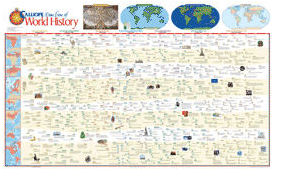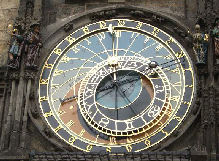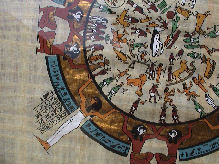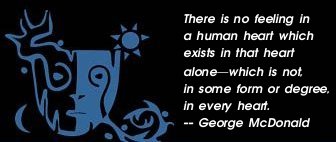|

About Time
Copyright © 2007 by Bill Bridges.
 Bill Bridges is the lead designer of White Wolf's "Mage: the Awakening" and "Promethean: the Created" games, along with the Storytelling system rules for all of White Wolf's World of Darkness games. He co-created the Fading Suns science fiction game universe for Holistic Design, and has written a couple novels based on game-worlds. He has also contributed to the scripts for a number of computer games. He has a Minor in Philosophy, which would have been a Major had he discovered a love for thinking earlier in his college career. He co-chairs the presenter programming for the bi-annual Mythic Journeys conferences in Atlanta, Georgia.
Bill Bridges is the lead designer of White Wolf's "Mage: the Awakening" and "Promethean: the Created" games, along with the Storytelling system rules for all of White Wolf's World of Darkness games. He co-created the Fading Suns science fiction game universe for Holistic Design, and has written a couple novels based on game-worlds. He has also contributed to the scripts for a number of computer games. He has a Minor in Philosophy, which would have been a Major had he discovered a love for thinking earlier in his college career. He co-chairs the presenter programming for the bi-annual Mythic Journeys conferences in Atlanta, Georgia.
And they all pretend they're Orphans
And their memory's like a train
You can see it getting smaller as it pulls away
And the things you can't remember
Tell the things you can't forget that
History puts a saint in every dream
— Tom Waits, "Time"
 We begin, as many things do, with a god. January belongs to Janus, "one of the oldest, holiest and most exalted of gods"1 among the Romans. He was named the "oldest of the gods and the beginning of all things."2 Not only is the first month his, but also the first day of each month. His chief festival took place on January 1st, which was made the official first day of the New Year in 153 B.C. He was the god of comings and goings, for in ancient times he opened the gates of heaven in the morning, driving forth his chariot, and closed them in the evening upon his return. Gates and arches were named for him, and those placed near crossroads and marketplaces were often dedicated to him. We begin, as many things do, with a god. January belongs to Janus, "one of the oldest, holiest and most exalted of gods"1 among the Romans. He was named the "oldest of the gods and the beginning of all things."2 Not only is the first month his, but also the first day of each month. His chief festival took place on January 1st, which was made the official first day of the New Year in 153 B.C. He was the god of comings and goings, for in ancient times he opened the gates of heaven in the morning, driving forth his chariot, and closed them in the evening upon his return. Gates and arches were named for him, and those placed near crossroads and marketplaces were often dedicated to him.
As god of beginnings, he was portrayed with two faces, one looking forward and the other back. To the Romans, the auspiciousness — or inauspiciousness — of an endeavor's beginning determined the tenor of its end. We retain this old belief in the ways we "ring in the New Year" today. If we party hard enough, surely the New Year will be just as fun all year 'round.
The theme for this month's Mythic Passages is Time. It's one of the great mysteries. Nobody really knows what it is — or even if it is; it could just be a figment of our imaginations. The discipline of geometry describes three-dimensional space, but there is no such mathematics for Time. We say that clocks measure the passage of time, but do they? They tick at their own pace and divvy up the moments of experience, but do they actually touch or reflect actual Time? Certainly not in the way other instruments, such as thermometers and tire gauges, measure natural phenomena.
What is Time? Thinking about it involves thinking about a host of topics: habit and repetition, the perception and conceptualization of experience, history, memory, eternity, physics, and myth. This short essay can't begin to touch on the depth and breadth of Time, a concept so large that we can't ever seem to grasp it whole in the mind. Perhaps, however, the soul knows more about it.
Soul Music
With the year still fresh and new, most of us use this time to declare the intent to make certain specific, sweeping changes to our lives: we make resolutions. We all know that most of these are never kept; they just don't take. But we hope that one or two will pierce through the fog of our daily habits and become routine. That's the trick, isn't it? Resolutions are about getting rid of habits we don't desire and adopting habits we do. They're about adding a new repetition, a new rhythm, to our daily lives, and ceasing to practice some of the old rhythms.
The rhythms of time, like musical rhythms, are about repetition. Like musical rhythms, they evoke a dance. The body moves in time to the beats of passing time: stepping forward and back, rising and falling, moving even in stillness as we breathe in and out. Bodily time is a pulse, the drumbeat of the heart, the pumping of the blood. Increasingly minute measurements of time — nanoseconds, picoseconds, femtoseconds — seem distant and abstract to our fleshly, lived sense of time.
Coming and Going
We often speak of time as being "ahead of us," but not all cultures see the future as waiting in the direction we're traveling. Some think of it as what's behind us — one can't see it approaching; one can only see in the direction one is looking, at one's past, what's already happened — what's been seen. We in the modern West, however, see the future ahead, beyond the far horizon. Our sense of time is intimately tied to spatial metaphors, as David Abram explores in The Spell of the Sensuous:
-
 ...we have begun to realize that the past and the future — these curious dimensions — may be just as much spatial as they are temporal. Indeed, we have begun to place these dimensions, to discern their location within the sensuous world. The conceptual abstraction that we commonly term "the future" would seem to be born from our bodily awareness of that which is hidden beyond the horizon — of that which exceeds, and thus holds open, the living present. What we commonly term "the past" would seem to be rooted in our carnal sense of that which is hidden under the ground — of that which resists, and thus supports, the living present. As ground and horizon these dimensions are no more temporal than they are spatial, no more mental than they are bodily and sensorial.3 ...we have begun to realize that the past and the future — these curious dimensions — may be just as much spatial as they are temporal. Indeed, we have begun to place these dimensions, to discern their location within the sensuous world. The conceptual abstraction that we commonly term "the future" would seem to be born from our bodily awareness of that which is hidden beyond the horizon — of that which exceeds, and thus holds open, the living present. What we commonly term "the past" would seem to be rooted in our carnal sense of that which is hidden under the ground — of that which resists, and thus supports, the living present. As ground and horizon these dimensions are no more temporal than they are spatial, no more mental than they are bodily and sensorial.3
Circles and Lines
Abram also states: "To indigenous, oral cultures, the ceaseless flux that we call 'time' is overwhelmingly cyclical in character." 4 This is what Mircea Eliade has called the "myth of the eternal return." Time as a circle. The "wheel of the year," with the months and seasons arrayed along the ever-turning circle's edge. The Great Year, the turning of world ages, comes after many revolutions, making way for a new Great Year cycle and more turns of the wheel.
 Our modern sense of time, however, is different. It's linear. The "arrow of time" is straight and travels in one direction: from the past through the present into the future. Historically, the concept of linear time came from a Jewish innovation in thought, a new way of relating to time and thus the universe. When linear time supplanted circular time, history became no longer an endless cycle of repetition, as seen in nature through the turn of seasons and the rhythms of aging in the human body. History now had a beginning, middle and end — an aim toward which it moved. It also had something new, literally: novelty. Whereas the earlier concept of time emphasized recurrence, the linear sense of time emphasized change — everything is new. Even if it seems similar to what has gone before, it's a new instance or manifestation of that phenomenon. As Heraclitus wrote, "You can't step into the same river twice."
Our modern sense of time, however, is different. It's linear. The "arrow of time" is straight and travels in one direction: from the past through the present into the future. Historically, the concept of linear time came from a Jewish innovation in thought, a new way of relating to time and thus the universe. When linear time supplanted circular time, history became no longer an endless cycle of repetition, as seen in nature through the turn of seasons and the rhythms of aging in the human body. History now had a beginning, middle and end — an aim toward which it moved. It also had something new, literally: novelty. Whereas the earlier concept of time emphasized recurrence, the linear sense of time emphasized change — everything is new. Even if it seems similar to what has gone before, it's a new instance or manifestation of that phenomenon. As Heraclitus wrote, "You can't step into the same river twice."
And yet, as useful as this form of thought has been for our material culture, it does seem to have cut us moderns off from the older, cyclical experience of time. We feel this kind of time in our bones and often in our dreams. To lose all sense of it is to lose sense of our bodies. Is there a metaphor we can use to unite these two truths, to get the best of both worlds? There is: the spiral.

Turn, Turn, Turn
We can experience time as both circular and linear, moving forward and turning in circles as it goes. In her book, The Tao of Chaos: DNA and the I Ching, Katya Walter says:
-
- The spiral is the supreme symbol of evolution. Combining cycle and line, it epitomizes entrainment [synchronization of rhythmic cycles] plus change; it replicates an old movement yet drives somewhere new. The spiral archetype is visible in the wheeling galaxy, the cyclone, the dirty water funneling down your sink drain, the DNA in your body. The spiral spins the cosmos together and knits us into being. 5
The nautilus shell is perhaps our most common image of the spiral. Its whorl epitomizes for us the Golden Mean, the perfect mathematical proportion. If so many natural systems move in spirals, why not Time?
Off the Clock
 Walter also points out the distinctions between the traditional analog clock face and the newer digital clock. The former "reveals the proportions of time in round, related cycles" 6. The latter "chops time into discrete units without showing their proportion to anything." 7 She adds that: "You just can't intuit the overall proportions in our time system by a linear [digital] watch". 8 Walter also points out the distinctions between the traditional analog clock face and the newer digital clock. The former "reveals the proportions of time in round, related cycles" 6. The latter "chops time into discrete units without showing their proportion to anything." 7 She adds that: "You just can't intuit the overall proportions in our time system by a linear [digital] watch". 8
Indeed, we don't always live by the clock, either analog or digital. We might use clocks as tools, but our own personal sense of time rarely conforms to the ticks of a clock. While some people seem to always know what time it is, most of us lose track of it when we daydream or get absorbed into some activity or other, only to emerge from our task later wondering what time it is. This sort of time is subjective. Sometimes, minutes seem to drag, while at other times they seem to fly past. Is this time any less real than clock time? Just because we can't necessarily synchronize our own subjective clocks to some universally recognized Mean Time or nuclear clock, do we have any less valid an experience of time's passage?
Rituals
 Even when living "off the clock," we still mark certain times as special. These days, holidays — holy days — are most often merely excuses to get off work. We rarely celebrate them with the same rituals our ancestors once used to evoke these days' potential timelessness, but when we do, time does recur. When people perform the same ritual on the same date over and over again, it enshrines that time, lifting it from the mundane calendar. It becomes the same time. As rhythms are shared across centuries, enacted at the same time in the same way, past and present are united. Even when living "off the clock," we still mark certain times as special. These days, holidays — holy days — are most often merely excuses to get off work. We rarely celebrate them with the same rituals our ancestors once used to evoke these days' potential timelessness, but when we do, time does recur. When people perform the same ritual on the same date over and over again, it enshrines that time, lifting it from the mundane calendar. It becomes the same time. As rhythms are shared across centuries, enacted at the same time in the same way, past and present are united.
The Mythic Passages magazine aims to explore these timely celebrations throughout the coming year, examining world traditions each month and marking the holidays, sacred times, and seasonal changes. Each month has a host of myths and gods to celebrate.
Even though the Jews invented linear time, they didn't give up time cycles, such as the seven-day week. The Sabbath has been viewed as the Temple of Jerusalem erected in time rather than space. That rather profound thought also seems to unite the two views of time — a recurring temple in the onrushing stream of time.
Such eddies in the stream — holidays in which time repeats itself — rely on a culture's memory to enable them. If they're forgotten, time is lost.
In Search of Lost Time
Time isn't what we think it is — or is it? All we really know of the past is memory. Everything else we assume on trust — trust that our historians, our elders, our favorite authors and even unearthed potsherds, are right about what they say occurred in the past. But even memory — especially memory — is faulty. When we try to remember something, it's sometimes a concoction of fantasy, what the ego wants to have happened rather than what actually happened. This form of conscious recall is unreliable, and yet so much of our lives depends on it.
There is another form of memory, what Proust called involuntary memory. This could also be called sensory memory, for it is most often invoked by sensory experience, especially smell. Some sight, sound, smell, taste or action causes a memory to rise up unbidden, in many cases more strongly and accurately than with conscious, intentional remembering. Involuntary memory recaptures time with an experiential intensity that is startling. But it's not the same as the immediate experience that is being remembered; it is still an artifact, no matter how alive it seems. This dichotomy might be why involuntary memory is so often tinged with nostalgia and longing.
Or perhaps we're not longing for lost time, but for the soul's sense of eternity that is ever present, if unnoticed most of the time.
Always and Forever
 We dream of endless Time, a state of grace undisturbed by the terrible changes and tragic losses we experience in this world, in the stream of time. Wise men say "And this, too, shall pass," and we know that it is all too true, whether as consolation or sorrowful curse. And yet still we have intimations of eternity.
Jacob Needleman writes in his book, Time and the Soul: We dream of endless Time, a state of grace undisturbed by the terrible changes and tragic losses we experience in this world, in the stream of time. Wise men say "And this, too, shall pass," and we know that it is all too true, whether as consolation or sorrowful curse. And yet still we have intimations of eternity.
Jacob Needleman writes in his book, Time and the Soul:
-
- When man is closer to the Self, time is no longer the enemy, so we are told by the ancient wisdom. It is the man who is less than Man whom time mercilessly destroys. It is the self that is less than the Self that is devoured by time.9
By the Self, Needleman means the soul, what is within us that is outside of Time. Wordsworth wrote of it:
-
- Our birth is but a sleep and a forgetting:
The Soul that rises with us, our life's Star,
Hath had elsewhere its setting,
And cometh from afar:
Not in entire forgetfulness,
And not in utter nakedness,
But trailing clouds of glory do we come 10
New Dimensions
 But is this how Time and eternity really is? That is, objectively, scientifically? Science is the model we moderns use to convince ourselves of what is real and what is not; or, put another way, what is worth our time and what is not. Concerning Time, however, nobody has a definitive answer, although many have put forward theories. The reigning scientific model comes from Einstein: time as the fourth dimension, part of the same "substance" as space — the space/time continuum. To travel in space is to travel in time, and even if we ourselves aren't moving, the ground we stand upon is, rotating on its axis in orbit around the Sun, which is itself turning in a spiral galaxy. If you could reverse this motion, as Superman did in Superman: The Movie, would you travel backwards in time? But is this how Time and eternity really is? That is, objectively, scientifically? Science is the model we moderns use to convince ourselves of what is real and what is not; or, put another way, what is worth our time and what is not. Concerning Time, however, nobody has a definitive answer, although many have put forward theories. The reigning scientific model comes from Einstein: time as the fourth dimension, part of the same "substance" as space — the space/time continuum. To travel in space is to travel in time, and even if we ourselves aren't moving, the ground we stand upon is, rotating on its axis in orbit around the Sun, which is itself turning in a spiral galaxy. If you could reverse this motion, as Superman did in Superman: The Movie, would you travel backwards in time?
If Time is the fourth dimension, then past, present and future already exist, whole and entire at once. Moving through the space/time continuum, we also move through the substance of time. Theoretically, if we were able to perceive from a fourth dimensional perspective, we could foresee the future and view the past. Our own lives would look like a photograph where the shutter was left open — multiple ghosts of ourselves moving through space.
There are other theories, such as quantum models of alternative universes (with alternative times), and recently, particles of time. They can get quite dizzying, although none yet has the virtue of widespread acceptance. They often seem impossible, fantastic... mythic.
Time is a Myth
So what does time mean for myth? This is a mythic magazine, after all. Myths are stories that take place outside of time: "Once upon a time...." Myths have been described as "eternal verities" and "timeless tales." Even though they take place neither in the past or the future (although they wear the clothes of those times), they still have deep meaning for the present. They teach that origins foretell endings, and that the time in between is where we learn this lesson the hard way, through trial.
William Irwin Thompson wrote:
-
- Myth, as a history of the soul, is still a history, and each stage of the evolution of consciousness generates its appropriate story. As the spiral of history turns, one archetypal story becomes the recapitulation of the old, the performance of the new, and the overture of what is to come.11
Myths, as touchstones to the Timeless, can help us quit fretting about time and how we "manage" it. Stories happen at their own pace, no matter how eager we are to get to the end. We should sit back and enjoy the ride.
Footnotes:
- Oskar Seyffert, Dictionary of Classical Antiquities, Meridian Library, 1957.
- Ibid.
- David Abram, The Spell of the Sensuous, Vintage Books, 1996 (pp. 214-215).
- Ibid, p. 185.
- Katya Walter, The Tao of Chaos: DNA and the I Ching, Element Books, 1996, p. 42.
- Ibid, p. 35.
- Ibid, p. 35.
- Ibid, p. 35
- Jacob Needleman, Time and the Soul, Berret-Koehler Publishers, 1983, p. 92.
- William Wordsworth, "Ode: Intimations of Immortality from Recollections of Early Childhood", .
- William Irwin Thompson, The Time Falling Bodies Take to Light, St. Martin's Press, 1981, p. 251.
Read more about Bill Bridges
Return to Mythic Passages Menu
Subscribe to the Mythic Passages e-magazine
|

